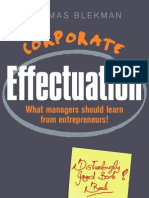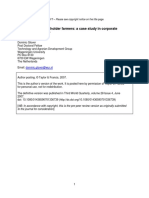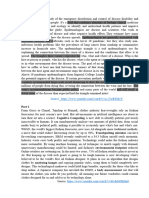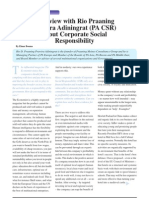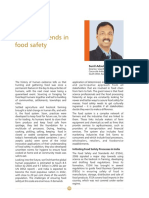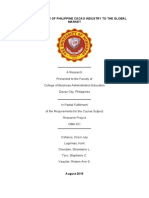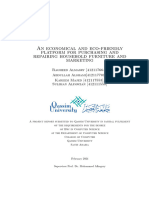Pdjose Interview With Auret Van Heerden: Strategy and The Sustainable Enterprise
Pdjose Interview With Auret Van Heerden: Strategy and The Sustainable Enterprise
Uploaded by
shashank singlaCopyright:
Available Formats
Pdjose Interview With Auret Van Heerden: Strategy and The Sustainable Enterprise
Pdjose Interview With Auret Van Heerden: Strategy and The Sustainable Enterprise
Uploaded by
shashank singlaOriginal Title
Copyright
Available Formats
Share this document
Did you find this document useful?
Is this content inappropriate?
Copyright:
Available Formats
Pdjose Interview With Auret Van Heerden: Strategy and The Sustainable Enterprise
Pdjose Interview With Auret Van Heerden: Strategy and The Sustainable Enterprise
Uploaded by
shashank singlaCopyright:
Available Formats
Strategy and the Sustainable Enterprise
P D Jose
Interview with Auret van Heerden
Interviewer: So, you have worked with a lot of companies to promote stakeholder engagement. Do
you have interesting stories about successes and failures in engaging with stakeholders?
Auret: You know, the issues in the supply chain are very big. If you map your supply chain from raw
materials, all the way, to recycling, and you do a risk analysis, you'll find many risks either human rights
risks or environmental risks at the raw materials phase, at the processing phase, at the manufacturing
phase, at the consumption phase, and all the way through to the recycling phase. And, generally or
often those risks are too big for any one actor to cooperate. So, you need partnerships, you need
alliances, you need coalitions of stakeholders in order to address those risks. And, often you need to
make some delicate tradeoffs and really complicated tradeoffs. You can't do everything. And no one
party has a right to make that tradeoffs. A company cannot decide who is, you know, whose rights are
more important, well, whose priorities come first. So, you need multi-stakeholder coalitions in order
to decide on those tradeoffs. And so, companies when they map their risks in their valued chain, they
should also map the actors—the stakeholders involved to each risks. So, the risk might be a water risk,
it might be a land use risk, it might be a human rights risk— a child labor risk. And, when they have
identified that risk, they need to map the actors—the stakeholders involved and get them all together,
so that you can then decide how to address that risk, and how to make the tradeoffs and the
compromises, which are probably involved. And, this is difficult for companies because companies are
used to acting on their own. And, managers like to have managerial prerogative. So, it's difficult for
them to work out how to communicate with the other stakeholders, and the other stakeholders as
well—NGOs and government agencies, and international organizations and local communities—are
particularly not used to talking to companies. And, sometimes, they don't trust the companies. So,
they're hesitant. They don't know if they can accept the company as a stakeholder or as a partner.
And so, it takes some brokerage, it takes some mediation to relegate all of these stakeholders
together. And, that's a lot of what I do. And, that's a lot of what we call multi-stakeholder initiatives
have to do. It's really great that communication, and that trust, and that working relationship between
the different stakeholders. So that, they can get cracking it. So, they can actually, roll up their sleeves
and get working on the particular issues which face them. And, you know, if you take a company like
Apple, which came to this work quite recently, they were being attacked by NGOs and even by the
media for not doing enough. Or is, in fact, they were doing a lot behind the scenes. They just weren't
talking about it. They weren't open about it. And, they weren't communicating it. So, one of the things
that Apple needed to learn was how to start talking to critical stakeholders and people who, good
faith, they didn't necessarily understand or accept. So, in China, for example, there's an environmental
activist called Ma Jun. And, Ma Jun setup an organization called the Institute for Public Education. I
believe it's called IPE. And, he was doing a map, a pollution map of China. And, he was mapping
factories which were polluting and linking them back to their brands who use those factories like Apple
or HP or Dell. And, Apple, at first, wouldn't talk to him. They saw him as a critic, as an enemy. And, it
took quite a lot of brokerage for Apple to sit down with Ma Jun and to realize that they have the same
goals. They're both trying to control pollution at factories in China. They're just coming at it in different
ways. And so now, Apple has some very valuable collaborations with Ma Jun where they've realized
that sharing information with him and with his pollution map helps everybody to clarify, to identify
risks in the supply chain. But, that's a real journey for companies and it's often a journey, which is
fraught with dangers. Often, you know, they hit potholes in the road as they make their journey.
© All Rights Reserved, Indian Institute of Management Bangalore 1
You might also like
- SPMS Lgu Trinidad BoholDocument26 pagesSPMS Lgu Trinidad BoholJoemar Cafranca100% (3)
- The 10 Foundational Principles of Public RelationsDocument8 pagesThe 10 Foundational Principles of Public RelationsJonas EsguerraNo ratings yet
- ImagineFX - Marchch 2022Document100 pagesImagineFX - Marchch 2022Milton Andrés Falconi100% (6)
- Exploring Business: Unit 1 - Assignment 1Document22 pagesExploring Business: Unit 1 - Assignment 1Anam RaisaNo ratings yet
- PR Process & ToolsDocument19 pagesPR Process & ToolsgarimaNo ratings yet
- VÄ N Hã A Kinh Doanh 2 Nhà M 6Document9 pagesVÄ N Hã A Kinh Doanh 2 Nhà M 6Tuyết Trinh NguyễnNo ratings yet
- Fair & Lovely MarketingDocument7 pagesFair & Lovely MarketingThiwanka Chameera Jayasiri100% (1)
- Dbitkbam Triple Bottom Approach - Corporate Environmental Responsibilty, CSR, Triple Bottom Approach-All Notes PDFDocument7 pagesDbitkbam Triple Bottom Approach - Corporate Environmental Responsibilty, CSR, Triple Bottom Approach-All Notes PDFSnehal KoliNo ratings yet
- The Capital of BiodiversityDocument3 pagesThe Capital of BiodiversitySabina SemenciucNo ratings yet
- A Study On Global CSR PracticesDocument6 pagesA Study On Global CSR PracticesSherin SunnyNo ratings yet
- Stakeholder Engagement - Practitioners' PerspectivesDocument88 pagesStakeholder Engagement - Practitioners' PerspectivesSandra GarLandNo ratings yet
- A Joosr Guide to... An Everyone Culture by Robert Kegan and Lisa Laskow Lahey: Becoming a Deliberately Developmental OrganizationFrom EverandA Joosr Guide to... An Everyone Culture by Robert Kegan and Lisa Laskow Lahey: Becoming a Deliberately Developmental OrganizationNo ratings yet
- Greenwashing PaperDocument7 pagesGreenwashing PaperAnimo TonibeNo ratings yet
- Green HushingDocument31 pagesGreen HushingMuna MazouzNo ratings yet
- Welcome To InvolvismDocument28 pagesWelcome To InvolvismJonathan MacDonaldNo ratings yet
- ENG Interview DougDocument5 pagesENG Interview DougDavid Ferreira VargasNo ratings yet
- Product (RED)Document9 pagesProduct (RED)Madison SheenaNo ratings yet
- CSR An OxymoronDocument3 pagesCSR An OxymoronJayson Villena MalimataNo ratings yet
- Dove - A Purpose - NotesDocument5 pagesDove - A Purpose - NotesLiam KeNo ratings yet
- Reading PracticeDocument3 pagesReading PracticeNguyễn Bảo ToànNo ratings yet
- Measuring The Power of Free: New Rules of Public RelationsDocument8 pagesMeasuring The Power of Free: New Rules of Public RelationsMahesh BhattNo ratings yet
- Understanding - Preventing - Greenwash PDFDocument41 pagesUnderstanding - Preventing - Greenwash PDFAnimo TonibeNo ratings yet
- COULSON-THOMAS - Responsible - Business - 2016Document9 pagesCOULSON-THOMAS - Responsible - Business - 2016Lucia LoaizaNo ratings yet
- What Is PR?: by Michael BlandDocument5 pagesWhat Is PR?: by Michael BlandDrifter RichardsonNo ratings yet
- Sybmm PR NotesDocument8 pagesSybmm PR NotesHarsh Shah100% (1)
- Lesson 1: About Public RelationsDocument5 pagesLesson 1: About Public RelationsTyger KhanNo ratings yet
- Summary of Zero to One: by Peter Thiel | Includes AnalysisFrom EverandSummary of Zero to One: by Peter Thiel | Includes AnalysisRating: 4.5 out of 5 stars4.5/5 (2)
- Influencing People Without Relying On Formal AuthorityDocument6 pagesInfluencing People Without Relying On Formal AuthorityAthar BaluchNo ratings yet
- Mid TermDocument23 pagesMid TermhadeerahmedNo ratings yet
- BRANDDocument5 pagesBRANDThanhh XuânNo ratings yet
- Lec 13 ASY Sustainability - A New Path To Corporate and NGO CollaborationsDocument4 pagesLec 13 ASY Sustainability - A New Path To Corporate and NGO Collaborationsnakshitabadala4No ratings yet
- The Greenwashing Machine: Is CSR More Than Communication?Document44 pagesThe Greenwashing Machine: Is CSR More Than Communication?Animo TonibeNo ratings yet
- BUS30031 - Assignment 1 Individual ReportDocument6 pagesBUS30031 - Assignment 1 Individual ReportGaayathri Shadiga ManiamNo ratings yet
- Effectuation For Non-ProfitsDocument10 pagesEffectuation For Non-ProfitsNur AgustinusNo ratings yet
- PR ToolsDocument3 pagesPR Toolsjibranktk111No ratings yet
- CORPORATE-NGO PARTNERSHIPS IN CSR ACTIVITIESDocument31 pagesCORPORATE-NGO PARTNERSHIPS IN CSR ACTIVITIESkhairuddin.ktfNo ratings yet
- ISM SynthèseDocument192 pagesISM SynthèseCéline LazzeriniNo ratings yet
- Monsanto and Smallholder FarmersDocument21 pagesMonsanto and Smallholder FarmersanvillemarieNo ratings yet
- BB211 - Chapter 1 - Corporate CommunicationDocument28 pagesBB211 - Chapter 1 - Corporate CommunicationShaun LewNo ratings yet
- Business CommunicationDocument9 pagesBusiness CommunicationShreyasi MishraNo ratings yet
- Entrepreneurial Notes Cbet Class-1Document38 pagesEntrepreneurial Notes Cbet Class-1kambafelix22No ratings yet
- 2023 - Anh 11 - Tuyen Quang - TranscriptDocument4 pages2023 - Anh 11 - Tuyen Quang - TranscripthuytranthaivinhNo ratings yet
- Public Relations (PR) .: Public Relations As Part of The Marketing Communications Mix. Public RelationsDocument3 pagesPublic Relations (PR) .: Public Relations As Part of The Marketing Communications Mix. Public RelationsDadedidoduNo ratings yet
- Matt Auten Project 2Document11 pagesMatt Auten Project 2api-743584125No ratings yet
- Barkema - Final Findings 1Document4 pagesBarkema - Final Findings 1Fekadu AlemayhuNo ratings yet
- Community RelationsDocument6 pagesCommunity RelationsDev LahiriNo ratings yet
- How Can You Manage Difficult PeopleDocument18 pagesHow Can You Manage Difficult PeopleClaudiaNo ratings yet
- Boulder Thesis Brad FeldDocument6 pagesBoulder Thesis Brad FeldChristine Maffla100% (2)
- Interview RioPraaning ADocument3 pagesInterview RioPraaning AEddy KasdionoNo ratings yet
- CASO GAP How GAP Engaged With Its StakeholdersDocument14 pagesCASO GAP How GAP Engaged With Its StakeholdersGeraldine MuñozNo ratings yet
- Beyond The Bottom Line: Putting Social Responsibility To Work For Your Business And The WorldFrom EverandBeyond The Bottom Line: Putting Social Responsibility To Work For Your Business And The WorldNo ratings yet
- A Monthly PeriodicalDocument14 pagesA Monthly PeriodicalSindhu BaluNo ratings yet
- Public Relations, Publicity, and Corporate Advertising: Learning ObjectivesDocument32 pagesPublic Relations, Publicity, and Corporate Advertising: Learning ObjectivesHoàng KhangNo ratings yet
- Lec 27Document13 pagesLec 27ShanmugapriyaNo ratings yet
- Much Ado About Scale - Beyond Profit, April - June 2010Document2 pagesMuch Ado About Scale - Beyond Profit, April - June 2010PEPYCambodiaNo ratings yet
- HP Case Study (1500 Words)Document6 pagesHP Case Study (1500 Words)Jnb ChiocoNo ratings yet
- LivingstonDocument5 pagesLivingstonMarcus Aaron Clein TabinNo ratings yet
- Culture and Climate in Entrepreneurial Organisation: Introduction: The Word EntrepreneurDocument5 pagesCulture and Climate in Entrepreneurial Organisation: Introduction: The Word EntrepreneurDurga Prasad100% (1)
- Green Washing 11Document20 pagesGreen Washing 11ValSNo ratings yet
- Pdjose How Can We Visualize Risks?: Strategy and The Sustainable EnterpriseDocument1 pagePdjose How Can We Visualize Risks?: Strategy and The Sustainable Enterpriseshashank singlaNo ratings yet
- Warmer Planet PDFDocument1 pageWarmer Planet PDFshashank singlaNo ratings yet
- PDJ SSE W03 P02 C03 PartB NewDocument1 pagePDJ SSE W03 P02 C03 PartB Newshashank singlaNo ratings yet
- Pdjose Crisis Management: Strategy and The Sustainable EnterpriseDocument2 pagesPdjose Crisis Management: Strategy and The Sustainable Enterpriseshashank singlaNo ratings yet
- Pdjose Introduction To Issues Management: Strategy and The Sustainable EnterpriseDocument2 pagesPdjose Introduction To Issues Management: Strategy and The Sustainable Enterpriseshashank singlaNo ratings yet
- Bhopal Case AnalysisDocument3 pagesBhopal Case Analysisshashank singlaNo ratings yet
- S25 Chapter.2 - Change in Profit Sharing Ratio.Document10 pagesS25 Chapter.2 - Change in Profit Sharing Ratio.santoshthallapaka2No ratings yet
- Emerging Trends in Food Safety: Sunil AdsuleDocument3 pagesEmerging Trends in Food Safety: Sunil AdsuleSunil AdsuleNo ratings yet
- Midterm Examination For AC11N: ProblemDocument1 pageMidterm Examination For AC11N: ProblemLeica JaymeNo ratings yet
- (20231011) Contract ALV - PT JOOWON TECH INDONESIADocument4 pages(20231011) Contract ALV - PT JOOWON TECH INDONESIAEarly Novie WidiantiNo ratings yet
- Beginner's Guide: Traditional RivetingDocument7 pagesBeginner's Guide: Traditional RivetingStephen NomuraNo ratings yet
- Acca Course With Work PermitDocument5 pagesAcca Course With Work Permitafazapfjl100% (2)
- CSR ChinaDocument23 pagesCSR ChinaMalahayati ZamzamNo ratings yet
- Risk Management ProcessDocument1 pageRisk Management ProcessadebiraNo ratings yet
- Ethical Climates and Their Effects On Organizational Outcomes - Implications From The Past, and Prophecies For The FutureDocument39 pagesEthical Climates and Their Effects On Organizational Outcomes - Implications From The Past, and Prophecies For The FutureAJAYSURYAA K S 2128204No ratings yet
- IGNOU - Examination Form AcknowledgementDocument2 pagesIGNOU - Examination Form AcknowledgementJeetu TuwariNo ratings yet
- Principles of Marketing FinalDocument39 pagesPrinciples of Marketing Finalapi-550948784No ratings yet
- Armand Feigenbaum: Born: 1922 Occupation: Engineer and Quality ControlDocument12 pagesArmand Feigenbaum: Born: 1922 Occupation: Engineer and Quality Controltatareddy100% (2)
- Dehydrated Fruit and VegetablesDocument17 pagesDehydrated Fruit and Vegetableskassahun meseleNo ratings yet
- Research Paper - Cacao Export FinalDocument29 pagesResearch Paper - Cacao Export FinalStephanie Tero100% (1)
- Topic 10Document14 pagesTopic 10Kendrick RomeroNo ratings yet
- Salient Features of The RCCDocument45 pagesSalient Features of The RCCSunny DaeNo ratings yet
- Oxford Brookes Resubmission Guide 2020-21 PDFDocument20 pagesOxford Brookes Resubmission Guide 2020-21 PDFoyesigye DennisNo ratings yet
- Phil Gold Processing & Refining Corp: RF Monthly-Lgm 3Document1 pagePhil Gold Processing & Refining Corp: RF Monthly-Lgm 3bonemarkcosNo ratings yet
- Principles of Money-Time Relationship (Part 2) : After Completing This Module, You Are Expected ToDocument10 pagesPrinciples of Money-Time Relationship (Part 2) : After Completing This Module, You Are Expected ToCyrelle EscritorNo ratings yet
- QuizDocument37 pagesQuizAnh TranNo ratings yet
- ECON 2123 Quiz 2Document4 pagesECON 2123 Quiz 2Charlie TsuiNo ratings yet
- Group 8 - MODIFIED 17 MAY 2022Document95 pagesGroup 8 - MODIFIED 17 MAY 2022rithik70325No ratings yet
- Yoga Fee Receipt PDFDocument2 pagesYoga Fee Receipt PDFPraveen TripathiNo ratings yet
- CTJV807 Adaptive Resource Management For Analyzing Video ST PDFDocument14 pagesCTJV807 Adaptive Resource Management For Analyzing Video ST PDFbhasutkarmaheshNo ratings yet
- An Economical and Eco FriendlyDocument18 pagesAn Economical and Eco FriendlyKareem CSNo ratings yet
- Tax Invoice/Bill of Supply/Cash Memo: (Original For Recipient)Document1 pageTax Invoice/Bill of Supply/Cash Memo: (Original For Recipient)UjjwalPratapSinghNo ratings yet
- Why Don't We Deduct The Steel Volume While Calculating The Concrete Volume in RCC StructuresDocument5 pagesWhy Don't We Deduct The Steel Volume While Calculating The Concrete Volume in RCC StructuressitaracommercialcomplexNo ratings yet
- Seagull PDFDocument80 pagesSeagull PDFromeo dela cruz100% (1)

































